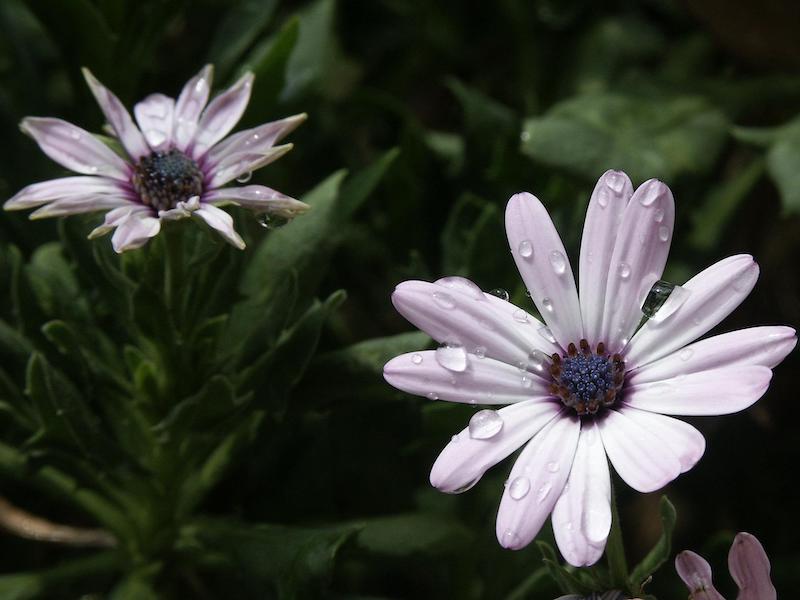Even though African Daisies are considered a drought-tolerant plant, they need consistent moisture to support the heavy blooming periods late in the spring and again late in the summer. Well-drained soil, rich in nutrients will help African Daisies thrive in a pot or the ground all growing season.

How To Tell If African Daisy Needs Watering
All plants have signs that they need watering. Sometimes the signs indicate that the plant has been dry for quite some time. Drooping leaves and flower stems signal the immediate need for moisture. In containers, the soil may become so dry that it shrinks away from the sides of the pot, potentially exposing the root system to too much air. Yellowing lower leaves with brown tips also indicates that the plant has been dry for a long time. Plants grown in the ground have the ability to send roots deep into the ground in search of moisture. Even if the top layer of soil appears to be dry, three or more inches below may have enough moisture needed to sustain growth.

How Often To Water African Daisy
African Daisy needs a moderate amount of water and will grow well with around one inch of water per week. If you garden in a dry climate that does not have regular rains during the summer, the watering will need to be split between 2 or 3 sessions a week. These long sessions will ensure the root systems grow deeper in the ground than if watered daily for a short period. Using a layer of organic mulch like compost or arborist chips also helps the soil retain moisture and keep the root zone cool.
African Daisies grown as annuals will not mature into established plants. They need to be treated like new plantings and watered on a regular basis. In the hardiness zones, 9-11, where African Daisy does grow as a perennial, watering can be reduced to a single long session once a week for established plants. During long periods of drought or heat, watering may need to be done more often. Watering with drip irrigation or soaker hoses helps the water get right where it's needed at the root zone with little evaporation or waste.
Container-grown African Daisy will need watering on a more regular basis. Let pots dry out a bit in between sessions. The top 2-3 inches should be fairly dry before watering to ensure the roots do not sit in waterlogged soil. During hot or dry periods, the need for watering should be checked daily. Smaller pots tend to dry out much faster than large containers and need more attention.
Drip irrigation with timers can be used for container-grown plants and simplify plant care. Set timers, so there is plenty of time between sessions for the pot to dry out and to prevent overwatering. The timers may need to be adjusted as the season progresses. Watering is needed less frequently during humid periods and during cool weather in the fall.
Best Time To Water African Daisy
Plants like to be watered early in the day. Watering early allows plants to dry their leaves completely before dark, cool nights. Soil temperature is generally cooler early in the day, allowing the water to penetrate deeper and more evenly, no matter the irrigation technique used. Watering can be reduced in the fall. African Daisies grown as annuals do not need watering after the first frost.
African Daisies grown in warmer climates will need supplemental watering through the winter if temperatures stay above 50 degrees F. Plants may need less watering when the weather is cooler or if grown in climates with heavy winter rains.
How to Water African Daisy
Step 1 - Check for dry soil
Feel the soil to see if it is dry and how far down. Soil can dry up to 3 inches below the surface before African Daisies need watering.
Step 2 - Look for drooping leaves or soil shrinking away from the side of a pot
These are visual clues that African Daisy needs watering immediately. Make sure to soak the soil well, let it drain for a while, and then give it another soaking. This method ensures the soil is fully rehydrated and the roots are saturated.
Step 3 - Water early in the day
Early watering ensures that the soil absorbs and retains as much water as possible. Any leaves that get watered will have the rest of the day to dry out.
Step 4 - Water in longer sessions spread further apart
Encourage deeper root growth by spacing out watering sessions during the week. Short sessions timed close together encourage the roots to stay close to the soil's surface. During periods of extreme heat or dryness, these shallow roots are more prone to damage.
African Daisy Watering Tips
- African Daisy needs to dry out between watering sessions to keep the roots from rotting
- Water container plants regularly because they will dry out faster than plants growing in the ground
- Deeper watering less often encourages deeper root formation
- Drip irrigation set on timers should be monitored through the season as the weather changes
 |
Author Robbin Small - Published 8-31-2022 |
